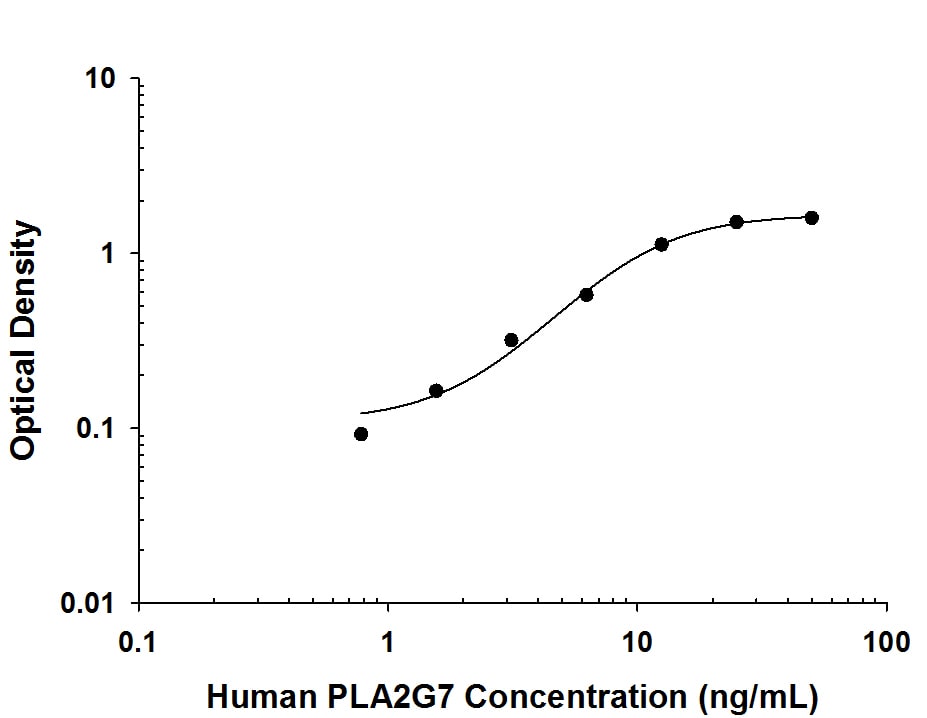Human PLA2G7/PAF-AH/Lp-PLA2 Antibody
R&D Systems, part of Bio-Techne | Catalog # MAB5106

Key Product Details
Species Reactivity
Applications
Label
Antibody Source
Product Specifications
Immunogen
Phe22-Asn441
Accession # Q13093
Specificity
Clonality
Host
Isotype
Scientific Data Images for Human PLA2G7/PAF-AH/Lp-PLA2 Antibody
Human PLA2G7/PAF‑AH/Lp‑PLA2 ELISA Standard Curve.
Recombinant Human PLA2G7/PAF-AH/Lp-PLA2 protein was serially diluted 2-fold and captured by Mouse Anti-Human PLA2G7/PAF-AH/Lp-PLA2 Monoclonal Antibody (Catalog # MAB51061) coated on a Clear Polystyrene Microplate (Catalog # DY990). Mouse Anti-Human PLA2G7/PAF-AH/Lp-PLA2 Monoclonal Antibody (Catalog # MAB5106) was biotinylated and incubated with the protein captured on the plate. Detection of the standard curve was achieved by incubating Streptavidin-HRP (Catalog # DY998) followed by Substrate Solution (Catalog # DY999) and stopping the enzymatic reaction with Stop Solution (Catalog # DY994).Applications for Human PLA2G7/PAF-AH/Lp-PLA2 Antibody
ELISA
This antibody functions as an ELISA detection antibody when paired with Mouse Anti-Human PLA2G7/PAF‑AH/Lp‑PLA2 Monoclonal Antibody (Catalog # MAB51061).
This product is intended for assay development on various assay platforms requiring antibody pairs. We recommend the Human PLA2G7/PAF-AH/Lp-PLA2 Quantikine ELISA Kit (Catalog # DPLG70) for a complete optimized ELISA.
Formulation, Preparation, and Storage
Purification
Reconstitution
Formulation
Shipping
Stability & Storage
- 12 months from date of receipt, -20 to -70 °C as supplied.
- 1 month, 2 to 8 °C under sterile conditions after reconstitution.
- 6 months, -20 to -70 °C under sterile conditions after reconstitution.
Background: PLA2G7/PAF-AH/Lp-PLA2
Secretory phopholipase A2 is an enzyme that hydrolyses the Sn-2 ester bond of phospholipids, generating free fatty acids and lysophospholipids (1‑3). Most secretory PLA2s are stored in cytoplasmic granules and are released in the extracellular environment on appropriate cell activation. Thus, they are present at higher concentration in the plasma and biologic fluids of patients with systemic inflammatory, autoimmune, or allergic disease, such as acute pancreatitis, rheumatoid arthritis, bronchial asthma, and allergic rhinitis. Also known as Lp-PLA2, PLA2G-VII is a plasma enzyme bound to lipoproteins: 80% bound to LDL, 15%-20% to HDL, and the remainder to VLDL (4-6). It is produced in major by mature macrophages and activated platelets. In contrast to other classical sPLA2s, PLA2G‑VII has poor specificity toward Sn-2 long chain fatty acids, unless heavily oxidized, and undergoes the catalysis of its substrates in the aqueous phase rather than at the interfacial surface of lipids. Thus, it has high specificity for water-soluble phospholipids in plasma including oxidatively‑modified phospholipids and platelet-activating factor (PAF). Because of the latter activity, it is also known as PAF acetylhydrolase (PAF-AH). Lack of human PLA2G‑VII is related to a higher risk for stroke and heart disease.
References
- Webb, N. R. (2005) Cur. Opin. Lipid. 16:341.
- Triggiani, M. et al. (2005) J. Allergy Clin. Immunol. 116:1000.
- Murakami, M. and Kudo, I. (2004) Biol. Pharm. Bull. 27:1158.
- Caslake, M. J. and Packard C. J. (2005) Nat. Clin. Prac. Cardiovasc. Med. 2:529.
- Karabina, S.-A., and Ninio, E. (2006) Biochim. Biophys. Acta, 1761:1351.
- Karasawa, K. (2006) Biochim. Biophys. Acta, 1761:1359.
Long Name
Alternate Names
Gene Symbol
UniProt
Additional PLA2G7/PAF-AH/Lp-PLA2 Products
Product Documents for Human PLA2G7/PAF-AH/Lp-PLA2 Antibody
Product Specific Notices for Human PLA2G7/PAF-AH/Lp-PLA2 Antibody
For research use only
